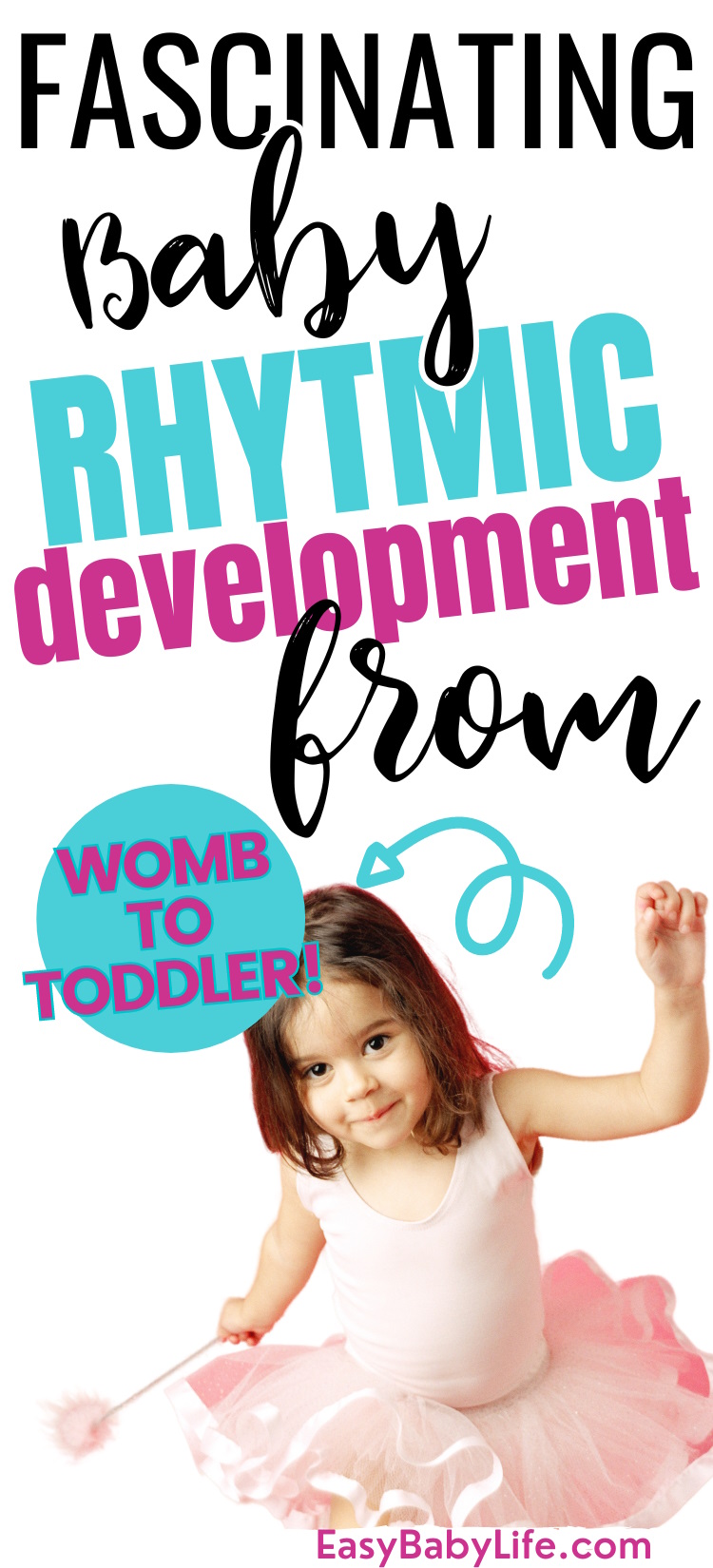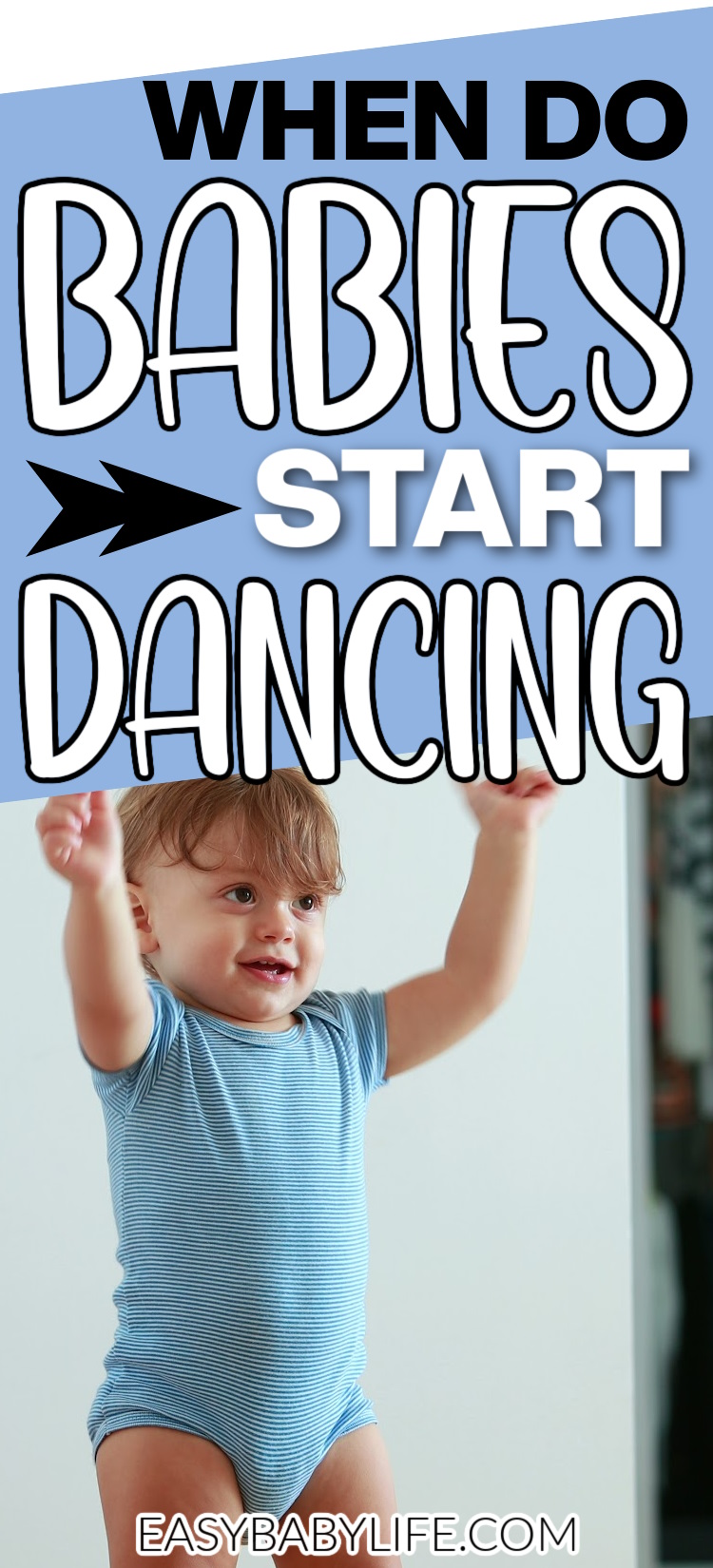
We’ve all seen the viral movies of children in diapers getting right down to the beat. We expect, “That’s unimaginable! How does that child have such a very good rhythm? May this be actual?”
The reality is that infants as younger as 0-6 months might begin dancing. My youngest son did. He “danced” to the beat of me grating carrots whereas in his excessive chair. Hillarious!
Research have proven that infants reply to music much more positively than speech, giving solution to the questions we glance into on this article: “When do infants develop a way of rhythm?” and “When do infants begin to dance?”
Let’s break it down and try what we learn about infants’ improvement of rhythm and dance and why dance is a vital a part of a child’s improvement. (The analysis references are listed under the article.)

When Do Infants Develop a Sense of Rhythm?
It’s a giant query: When do infants develop a way of rhythm? And the response is a little more sophisticated than simply saying: “At X months previous”. So right here, let’s break it down with the science that has sought to determine how and when infants reply to music.
Within the Womb
Simply in the identical means that infants can hear and acknowledge voices within the womb, they will hear and expertise music. Particularly starting within the second trimester infants develop listening to. One examine confirmed that at 16 weeks gestation, infants responded to music by opening their mouths and protruding their tongues.
Different research show that infants who take heed to music earlier than delivery exhibit optimistic bodily responses after they hear the music after delivery. This implies that newborns profit from listening to music earlier than and after they’re born.
Untimely Infants
For infants born prematurely, it has been proven that listening to music advantages their improvement. A bunch of infants in NICU born at or after 32 weeks, skilled improved very important indicators, feeding, and sleeping when uncovered to music. Particularly, these infants demonstrated nice enchancment when mother and father sang lullabies to them.
5–24 Month Olds
A examine of kids between the ages of 5 and 24 months has proven that youngsters could also be born with the innate means to answer rhythm. Particularly, infants reply extra to music than to speech.
Dad and mom in a survey famous that they observed their child dancing earlier than they might even crawl. Some as younger as 5 months previous have been identified to get right down to the beat.
At 8 months previous, infants will change their dance actions between quick and gradual to match the tempo of songs. They’ll additionally inform if somebody is dancing off-beat.
Taking it even additional, infants turn into even happier after they can transfer to the beat. They actually smile extra when shifting with the beat.
When Do Infants Begin to Dance?
0–12 Months
Most mother and father discover their baby begins to bop alongside to the music after they begin to stand, which occurs across the 12-month mark. However the reality is that some little ones start to point out indicators of dancing as early as 5 months previous. In a examine throughout 15 nations, half of oldsters surveyed stated their baby started to bounce at 6 months previous.
Though youngsters as younger as 8 months previous can inform if somebody is dancing on or off beat, they don’t have the flexibility and precision to bounce to the rhythm themselves. This usually doesn’t occur till preschool age.
12–24 Months
Across the time that little ones can begin to stand on their very own, the dancing actually will get going. Research have proven that 90% of infants exhibit actions acknowledged as dancing by the point they’re 12.8 months previous.
What’s tremendous fascinating is that these infants didn’t simply do it as soon as in a blue moon. As a substitute, these little ones usually danced at the least as soon as a day, growing their strikes over time. Particularly, by the point they have been 18 months previous, 80% mimicked actions they noticed and included them into their dance.
So, what can we perceive from this? Most infants can begin dancing by the point they’re a yr previous. And in the event that they do it usually with grown-ups exhibiting them how, they are going to develop their dancing as they develop.
Approaching their second birthday is when little ones will start to grasp leaping with each toes and balancing on one leg. So prepare, because the dance strikes actually start to take off at this stage.
3 Years and Up
When your toddler is about 3 years previous, they’re beginning to perceive play, motion, and social cues. That is the right level to affix extra formalized courses. In case your baby is exhibiting curiosity, give it a strive. But when it doesn’t appear to be their factor, don’t fear! Maintain the dancing going at house.
You’ll see that at this stage, your toddler will start to develop their very own dance fashion. It may be a good time to point out them easy methods to do just a few dance strikes of your individual.
Why is Dancing Essential?
Mind Improvement
May it’s potential that music and dance assist the event of your child’s mind? Sure! Amazingly, research have proven simply that. In a single examine, infants as younger as 9 months previous confirmed a rise within the means to course of each music and speech.
One other examine concluded that youngsters uncovered to music and music instruction present enhanced mind improvement in comparison with those that not uncovered.
Dancing fosters mind improvement in so some ways: Watching and mimicking the actions of others workout routines reminiscence. Spatial consciousness is found by shifting the physique. The bodily motion of dance stimulates the vestibular receptors and system within the inside ear. This enables the infant to grasp the place they’re in house which is on the basis of studying.
Bonding
Dancing is an effective way to bond together with your toddler. Research have proven that actions involving music and dance really create a stronger bond between infants and caregivers.
Particularly, when new mothers interact in actions involving music and dance with their infants (2-6 months previous), the interactions between the 2 considerably enhance. So, in the event you dance round together with your toddler, whilst early as 2 months previous, your bond will solely get stronger.
Happiness
This can be a given, however dancing makes folks joyful. As adults, we all know the advantages of dance – it will get our endorphins going and our blood pumping, and, most significantly, it places a smile on our faces.
So, it’s no marvel that the identical factor occurs for our little ones. A child’s success in coordinating actions with the beat has been proven to make infants happier and smile extra.
Socialization
Dancing is a social exercise. Sure, you could possibly dance in your room alone, however a lot of the time dancing is one thing to be shared with others. This has a big impact on a child’s social improvement.
As we dance collectively, little ones interact with others by watching them, copying them, and being joyful collectively. However even after the dance is over, optimistic social behaviors proceed.
A 2017 examine confirmed that youngsters who created music collectively have been extra possible to assist one another and cooperate with out being prompted to take action. So, even in the event you’re not singing the “Clear Up Tune”, little ones will be part of one another to assist tidy up the room.
Extra Advantages
Dancing advantages a child’s improvement in so many extra methods, together with:
- Hand-eye coordination
- Spacial consciousness
- Stability
- Gross and tremendous motor abilities
- Audio and visible stimulation
- Creativity and self-expression
Find out how to Stimulate a Child’s Dancing?
Within the Womb
Whereas within the consolation of your stomach, your child was always listening to the rhythm of your pulse. By experiencing an ideal beat all through the being pregnant, it’s no marvel that infants actually reply positively to the beat and rhythm of music.
So, what does this imply for you and your little bundle of pleasure? The thought is that in the event you repeatedly play a music earlier than your child is born, they will acknowledge it after delivery. This may very well be an effective way to assuage your new child.
So, think about using a selected playlist while you’re resting in the previous couple of months of being pregnant. You could possibly use it to assist your new child cool down after delivery.
Dancing With the Little Littles
Simply because just a little one can’t sit up on their very own doesn’t imply they need to be overlooked of the enjoyable! For infants 0-4 months previous be certain they’re absolutely supported. Lay them on a safe floor or bouncer whereas dancing round them or shifting their limbs to the beat for them.
It’s all the time enjoyable to make them your dance accomplice. Whether or not in a safe child provider or in your arms, all the time be sure that your child’s head is absolutely supported. Get right down to the beat, however simply don’t transfer too rapidly.
Bear in mind, they’re used to the rhythm of your heartbeat, so swaying, bopping, or rocking to an analogous tempo is greatest.
Mannequin the Dance Strikes
All eyes on you! The easiest way to get your toddler to bounce is to get into the groove your self. Present your toddler how a lot you benefit from the music and transfer to the beat.
Placed on the music and let your self bop round whereas doing each day duties like feeding, cleansing, and altering a diaper. This can be a nice solution to present the worth of music.
When the temper is correct, then flip it right into a full-on impromptu household dance social gathering! Getting everybody concerned, together with older siblings and caregivers, is just not solely enjoyable, it’s among the best methods to stimulate your child to bounce.
Dance & Music Lessons
Dance courses for kids are usually provided for little ones starting at 2–3 years of age. This can be a nice solution to promote stability, coordination, flexibility, and social abilities. It’s additionally an effective way to arrange for preschool by following directions and actions.
Many courses at this age contain father or mother participation, which creates a safe surroundings on your child whereas modeling classroom-ready behaviors.
Different music classes are offered for babies and their caregivers geared for kids 0–2 years previous. Many have courses particularly designed for kids from 0–8 months previous. So you possibly can carry your child, who’s just a few weeks previous. These courses are an effective way to reveal little ones to the marvel of music. I took certainly one of my sons to a music class when he was only a child. A lot of enjoyable, and also you’ll discover my ideas for achievement within the above linked article.
Get into singing and studying songs that you may proceed to sing at house. As they develop, little ones may even love to choose up devices and see how they produce sound and get into dancing to the music.
Dance vs Speak
Everyone knows the significance of speaking together with your toddler even earlier than they’re verbal. Nonetheless, research have really proven that infants reply extra positively to music than they do to conversational speech. So, what’s the perfect factor to do? Incorporate each music and discuss as methods to have interaction together with your child.
Takeaway
So, what’s the conclusion of this dive into the science of child dancing and rhythm improvement? If the takeaway may be boiled down to at least one phrase, it’s this one:
Dance!
Dance together with your child, your toddler, and your older baby. Expose them to music, rhythms, and dancing as quickly as potential, and have enjoyable collectively! Infants and even preemies and unborn infants (!) react positively to music; it enhances their mind improvement and places a smile on their faces. There are actually no drawbacks to including music to your baby’s life!
Learn Subsequent
Analysis references
-
- Movalled, Okay., Sani, A., Nikniaz, L. et al. The impact of sound stimulations during pregnancy on fetal learning: a systematic review. BMC Pediatr 23, 183 (2023). https://doi.org/10.1186/s12887-023-03990-7
- Kim, M., & Schachner, A. (2023). The origins of dance: Characterizing the development of infants’ earliest dance behavior. Developmental Psychology, 59(4), 691–706. https://doi.org/10.1037/dev0001436
- Loewy J, Stewart Okay, Dassler AM, Telsey A, Homel P. The effects of music therapy on vital signs, feeding, and sleep in premature infants. Pediatrics. 2013 Might;131(5):902-18. doi: 10.1542/peds.2012-1367. Epub 2013 Apr 15. PMID: 23589814.
- Marcel Zentner, Tuomas Eerola Rhythmic engagement with music in infancy, Proceedings of the Nationwide Affiliation of Sciences of america of America, March 15, 2010 107 (13) 5768-5773 https://doi.org/10.1073/pnas.1000121107
- Zhao, T. C., & Kuhl, P. Okay. (2016). Musical intervention enhances infants’ neural processing of temporal structure in music and speech. PNAS, 113(19), 5212–5217.
- Assal Habibi, B. Rael Cahn, Antonio Damasio, Hanna Damasio, Neural correlates of accelerated auditory processing in children engaged in music training, Developmental Cognitive Neuroscience, Quantity 21, 2016, Pages 1-14, ISSN 1878-9293, https://doi.org/10.1016/j.dcn.2016.04.003.
- Vlismas, Wendy & Malloch, Stephen & Burnham, Denis. (2013). The effects of music and movement on mother–infant interactions. Early Child Development and Care. 183. 10.1080/03004430.2012.746968.
- Kirschner, S., & Tomasello, M. (2010). Joint music making promotes prosocial behavior in 4-year-old children. Evolution and Human Behavior, 31(5), 354–364. https://doi.org/10.1016/j.evolhumbehav.2010.04.004

Paula Dennholt based Straightforward Child Life in 2006 and has been a passionate parenting and being pregnant author since then. Her parenting method and writing are based mostly on research in cognitive-behavioral fashions and remedy for kids and her expertise as a mom and stepmother. Life as a father or mother has satisfied her of how essential it’s to place relationships earlier than guidelines. She strongly believes in optimistic parenting and a science-based method.
Paula cooperates with a team of pediatricians who help in reviewing and writing articles.
Trending Merchandise











